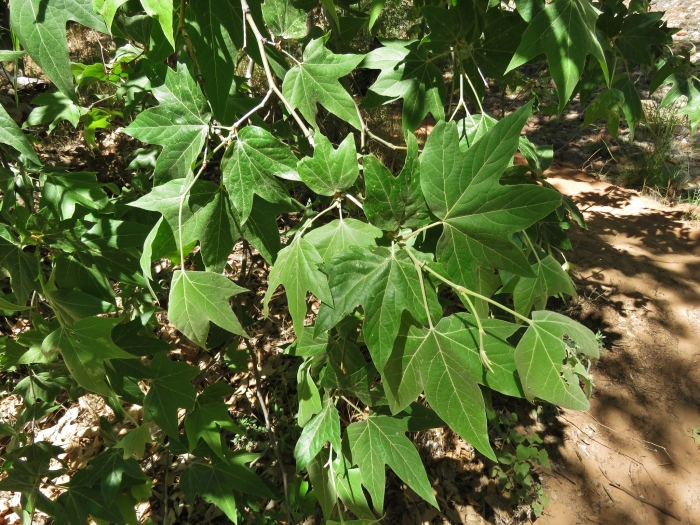Arizona Sycamore
(Platanus wrightii)
Arizona Sycamore (Platanus wrightii)
/
/

Annika Lindqvist
CC BY 4.0
Image By:
Annika Lindqvist
Recorded By:
Copyright:
CC BY 4.0
Copyright Notice:
Photo by: Annika Lindqvist | License Type: CC BY 4.0 | License URL: http://creativecommons.org/licenses/by/4.0/ | Rights Holder: Annika Lindqvist | Publisher: iNaturalist | Date Created: 2017-05-22T11:06:10-07:00 |
























































Estimated Native Range
Summary
Platanus wrightii, commonly known as Arizona Sycamore, is a deciduous tree native to riparian areas along streams and rivers, as well as canyons and floodplains in the Southwestern USA and Northwestern Mexico. It can reach heights of 45-90 feet (14-27 meters) with a width of 15-40 feet (5-12 meters), and it features a broad, spreading canopy with large, lobed leaves that turn golden-yellow in the fall. The bark is distinctive, with a mottled pattern of white and brown that exfoliates to reveal a creamy white inner bark, making the tree particularly striking in winter landscapes.
Arizona Sycamore is valued for its fast growth and its ability to thrive in riparian environments, contributing to soil stabilization and providing habitat for wildlife. It is often used in naturalistic plantings, as a shade tree in parks and large gardens, and for restoration projects. This tree prefers full sun but can tolerate partial shade and requires regular water to mimic its natural riparian habitat, especially during dry periods. It is adaptable to a range of soil types, provided they are well-drained. While it is drought-tolerant once established, it will not exhibit its best growth under low water conditions. Gardeners should be aware that the Arizona Sycamore can be susceptible to anthracnose and sycamore lace bug, and its large size and root system may not be suitable for small residential landscapes.CC BY-SA 4.0
Arizona Sycamore is valued for its fast growth and its ability to thrive in riparian environments, contributing to soil stabilization and providing habitat for wildlife. It is often used in naturalistic plantings, as a shade tree in parks and large gardens, and for restoration projects. This tree prefers full sun but can tolerate partial shade and requires regular water to mimic its natural riparian habitat, especially during dry periods. It is adaptable to a range of soil types, provided they are well-drained. While it is drought-tolerant once established, it will not exhibit its best growth under low water conditions. Gardeners should be aware that the Arizona Sycamore can be susceptible to anthracnose and sycamore lace bug, and its large size and root system may not be suitable for small residential landscapes.CC BY-SA 4.0
Plant Description
- Plant Type: Tree
- Height: 45-90 feet
- Width: 15-40 feet
- Growth Rate: Moderate
- Flower Color: N/A
- Flowering Season: Spring
- Leaf Retention: Deciduous
Growth Requirements
- Sun: Full Sun
- Water: Medium
- Drainage: Fast, Medium
Common Uses
Bee Garden, Bird Garden, Butterfly Garden, Fire Resistant, Low Maintenance
Natural Habitat
Native to riparian areas along streams and rivers, canyons, and floodplains in the Southwestern USA and Northwestern Mexico
Other Names
Common Names: Aliso, Sicomoro, Álamo
Scientific Names: , Platanus wrightii, Platanus racemosa var. wrightii, Platanus racemosa subsp. wrightii, Platanus racemosa var. wiightii,
GBIF Accepted Name: Platanus wrightii S.Watson